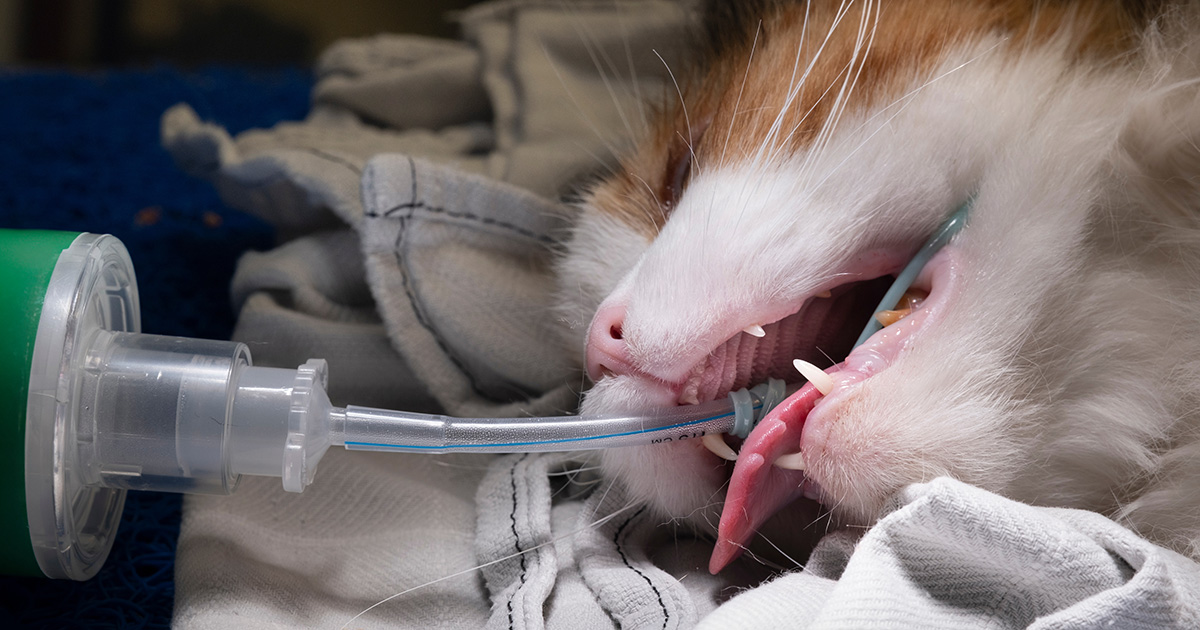Is cuffing endotracheal tubes during cat anaesthesia an old wives tail, or can we CATapult some new ideas into the modern day?
From day one as a veterinary nurse or vet, it is drilled into us to use uncuffed or cuffless endotracheal tubes (ET tubes) for any anaesthetics involving cats. The main reason behind this is to prevent injury to the trachea, mucosal layer or throat, and to reduce the risk of laryngospasm, which cats are especially prone to.
Due to these bodily structures being so delicate, there are safe methods that should be implemented to prevent trauma while both intubating and transporting anaesthetised cats.
Unpopular opinion?
Regardless of how many research papers are produced, or studies carried out discussing cuffed and uncuffed results, every vet and nurse will have their own opinion as to which they prefer and perceive to be safest.
Although there is a risk, carrying out cuffing tubes in a safe manner will reduce these risks – as such, I personally think a cuffed ET tube should be used when appropriate.
My own practice tends to avoid the use of cuffed tubes as a standard protocol, however, this is something I would like to encourage a group discussion about. After discussing with some other veterinary friends further afield – and from my own experience in a previous practice – there is a very mixed opinion alongside a varying protocol from practice to practice.
Tube types
As I mentioned previously, safety measures should be implemented to avoid trauma if using a cuffed tube. One such measure involves considering the type of ET tube used:
Low-volume high-pressure (LVHP) ET tubes – commonly seen in a bright orange colour – can be good for sealing off an airway, but the high pressure can stretch the walls of the trachea outwards, which will cause damage to cats1.
Alternatively, low-pressure high-volume (LPHV) tubes (as the name suggests) require a higher volume of air to inflate but, due to the material and construction, place less pressure on the larynx and trachea by moulding to the shape of the structures, in turn reducing the risk of stretching or irritating them1. This also makes it safer in the instance a tube has to be removed partially cuffed in an emergency.
Benefits of cuffing
My practice has both types of ET tube, and as they have these LPHV, I would love to encourage more research and discussion of these to implement cuffing for certain procedures.
As we know, dental procedures require an influx of water into the mouth and although throat packs are used, these soak through or may not be placed correctly, therefore a slight cuff could prevent aspiration of any excess water.
This same aspiration complication can be seen in patients at high risk of regurgitation. An example of this – which I have experienced first-hand – is an exploratory laparotomy or gastrostomy, in which pre-emptively cuffing a tube will prevent any further problems or required treatment for aspiration issues.
Gas leak
When cuffing, we mainly think about the reasons for doing so with regards to the patient, however, this can be a huge safety measure for staff also.
If for any reason we are unable to intubate with a suitably sized ET tube, or the trachea relaxes after induction, this can cause leakage around the tube, leaving those involved in the anaesthetic procedure exposed to volatile gas. I currently work alongside several pregnant colleagues, so this safety concern is something I am much more conscious about.
For those who are still wary about cuffing, or overinflating a cuff, a sterile lube can be used, as this helps to not only glide the tube down the throat smoothly but helps to create a squishy thin layer as an extra seal to the gas2.
Safe intubation
Some practices, including my own, supply a Tru-Cuff syringe, which accurately determines how much pressure can be added to each ET tube, preventing any overinflation. Of course, with any cat intubations, a local anaesthetic should be used to spray the throat 90 seconds before intubating, aiding in smooth intubation and helping prevent the larynx from laryngospasm.
Ultimately, this topic is a good discussion point within each practice as there are both pros and cons to both cuffed and uncuffed ET tubes, and if safety measures are implemented within the intubation protocol, then the risk of laryngeal and tracheal injury is low.
Personally, I believe it is worth cuffing as the pros for both patient and staff are paramount.

Leave a Reply